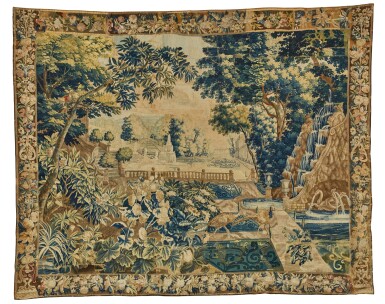Design 17/20: Furniture, Silver, Ceramics & Clocks
Design 17/20: Furniture, Silver, Ceramics & Clocks

Property from an Important English Private Collection
A Flemish Verdure tapestry, probably Lille, early 18th century and later
Lot Closed
November 9, 02:08 PM GMT
Estimate
4,000 - 6,000 GBP
Lot Details
Description
Property from an Important English Private Collection
A Flemish Verdure tapestry, probably Lille, early 18th century and later
Woven with a landscape with formal gardens incorporating a rockwork waterfall with sculptural water features and scroll designed parterre, the foreground with elaborate flowering plants and birds and a brightly feathered parrot in the branches of the flanking trees, further formal gardens and waterfalls extend beyond a balustrade into the distance, all within a wide floral border against a walnut coloured ground
Approximately 269cm high, 340cm wide; 8ft 10in., 11ft. 2in.
